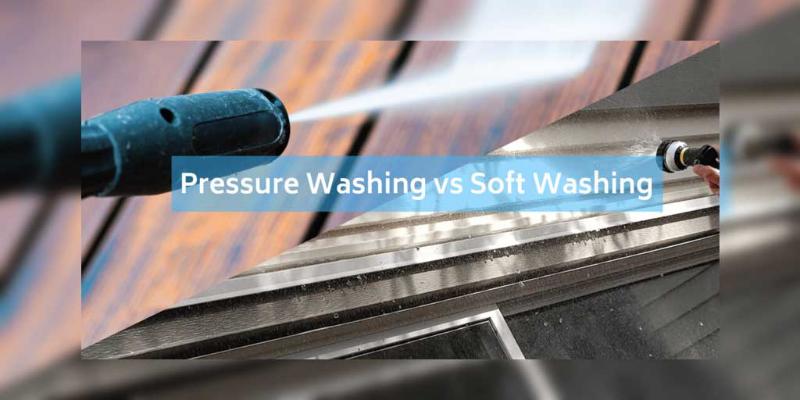Soft Washing vs. Pressure Washing: Key Differences & Best Applications
Choosing the Right Exterior Cleaning Method
When it comes to exterior cleaning, two primary methods dominate the industry: soft washing and pressure washing. While both techniques effectively remove dirt, grime, and contaminants, they serve different purposes and require distinct equipment and cleaning solutions.
Understanding these differences helps homeowners, business owners, and cleaning professionals determine the best approach for each job. This guide breaks down the key features, applications, and recommended products for both cleaning methods.

What is Soft Washing?
Soft washing is a low-pressure cleaning technique that uses biodegradable cleaning solutions to break down dirt, mold, algae, and other contaminants. Unlike pressure washing, which relies on force, soft washing safely cleans delicate surfaces without causing damage.
Key Features of Soft Washing:
- Uses low pressure (under 500 PSI).
- Relies on specialized cleaning solutions instead of high-pressure water.
- Prevents damage to siding, roofs, and wooden surfaces.
- Provides long-lasting results by eliminating organic growth at the root.
Best Applications for Soft Washing:
- Roof Cleaning - Removes moss, lichen, and algae without damaging shingles.
- Vinyl & Wood Siding - Prevents cracking, chipping, or water damage.
- Stucco & Drywall Exteriors - Cleans surfaces safely without erosion.
- Fences & Decks - Maintains wood and composite materials without splintering.
Recommended Soft Washing Products:
- Sodium Hypochlorite - Kills mold, mildew, and algae at the root.
- Surfactants - Helps cleaning solutions adhere to surfaces for longer dwell times.
- Soft Wash Pumps & Sprayers - Ensures even application of the cleaning solution.
Soft washing is ideal for surfaces that require gentle yet effective cleaning and where high pressure could cause damage.
What is Pressure Washing?
Pressure washing, also called power washing, uses high-pressure water (ranging from 2,000 to 4,000+ PSI) to blast away tough stains, grease, dirt, and debris. This method is highly effective on durable surfaces that can withstand intense force.
Key Features of Pressure Washing:
- Uses high-pressure water to remove dirt and grime.
- Effective for Effective for stubborn stains, grease, and mildew.
- Best suited for hard, non-porous surfaces.
- Requires proper handling to avoid surface damage.
Best Applications for Pressure Washing:
- Concrete Driveways & Walkways - Removes oil stains, dirt, and mildew.
- Brick & Stone Exteriors - Cleans surfaces without the need for chemicals.
- Patios & Pavers - Lifts deeply embedded grime and organic buildup.
- Heavy Equipment & Vehicles - Removes grease, industrial debris, and mud.
Recommended Pressure Washing Products:
- Pressure Washers & Nozzles - Essential for tackling tough cleaning jobs.
- Degreasers & Stain Removers - Breaks down oil, grease, and stubborn dirt.
- Surface Cleaners - Ideal for large, flat areas like driveways and parking lots.
Pressure washing is the best choice for deep cleaning hard surfaces where dirt and stains require powerful water force for removal.
| Feature | Soft Washing | Pressure Washing |
|---|---|---|
| PSI Level | Low (under 500 PSI) | High (2,000–4,000+ PSI) |
| Cleaning Method | Chemical-based, gentle rinse | High-pressure water blast |
| Best for | Roofs, siding, wood, stucco, fences | Concrete, brick, stone, patios, heavy equipment |
| Effectiveness | Kills mold, algae at the root, prevents regrowth | Removes dirt, grime, and stains instantly |
| Risk Level | Low risk of damage | Can cause damage if used improperly |
When to Use Soft Washing vs. Pressure Washing:
- Choose soft washing if dealing with mold, algae, or mildew on delicate surfaces like roofs, siding, and stucco.
- Use pressure washing for stubborn dirt, grease, or stains on hard, durable surfaces like concrete, brick, and heavy machinery.
Both methods require proper cleaning chemicals and equipment to achieve the best results while minimizing the risk of damage.
Selecting the Right Exterior Cleaning Method
Using the correct cleaning technique is essential for maintaining the integrity and appearance of exterior surfaces.
- Soft washing is ideal for killing organic growth and protecting delicate surfaces.
- Pressure washing is best for removing heavy dirt, stains, and grime from hard surfaces.
- Proper equipment, nozzles, and cleaning solutions maximize effectiveness and prevent damage.
For professional-grade cleaning chemicals, pressure washing equipment, and soft washing solutions, visit LNI Equipment. We provide high-quality products to help you tackle any exterior cleaning project with confidence.
Upgrade your cleaning process today. Shop now at LNI Equipment.
